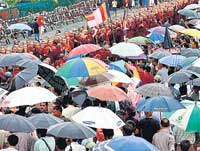
Monk power shakes juntaTheir peaceful tactics catch Govt. off guard BANGKOK, Saturday (AP)- Armed only with upturned begging bowls, chanting Buddhist monks in Myanmar have caught the country's military rulers off guard with their peaceful protests. They have emboldened the public to take to the streets by the thousands to support the most dramatic anti-government protests the isolated Southeast Asian nation has seen in a decade. Braving monsoon rains, monks in traditional maroon robes demonstrated for a fourth straight day Friday in the country's largest city, Yangon. Followed by clapping onlookers, about 1,500 monks marched after praying at the Shwedagon Pagoda, the nation's holiest shrine and a gathering place for anti-government demonstrations including the failed 1988 democratic uprising. The monks, who are widely respected in the mostly Buddhist society, bring moral authority to the movement with their nonviolent practices and sheer numbers: There are 500,000 in monasteries across the country. Their assumption of a leadership role in protests poses perhaps the gravest threat to the junta since the 1988 uprising when the military fired on peaceful crowds, killing thousands and terrorizing the country.
It has put the regime in a quandary over whether to crack down or take a chance and allow the protests to run their course. Josef Silverstein, a Myanmar expert and retired Rutgers University professor, said the junta may be hesitating to act until it assesses how many monks support the protests and who is actually leading them. Yet waiting much longer could be risky. ''The monks are showing that without arms and nothing more than prayers and marching that they are capable of having greater freedom than people have had,'' he said. ''This could encourage people to be more resistant. The longer this stalemate goes on, the weaker the military looks to the country and outside.'' Images of the monks have increased support for the opposition's cause worldwide. Washington, the United Nations and Hollywood stars have called on the junta to enact democratic reforms and release the leader of the pro-democracy opposition, Nobel Peace Prize laureate Aung San Suu Kyi, along with other political prisoners. The current demonstrations are the most militant since December 1996, when students gathered in Yangon to demand improvements in education and the right to organize in a union. The military, which has controlled Myanmar since 1962, has withstood waves of domestic and international protests since 1988 and shows no signs of yielding now. Even if the people are angry and emboldened, and the junta is treated as a pariah by the West, there are no signs of disunity in the army. And the support of neighboring nations, most notably China, as well as oil and gas revenues, keep the military in a commanding position. Aung Zaw, a Burmese editor of The Irrawaddy, a Thailand-based magazine that covers Myanmar, said the military knows that brutalizing the monks could prompt the wider public -- which has largely remained on the sidelines -- to join the protests. ''Authorities are at odds over how to deal with the monks at the point. As you know, monks are respected and influential people,'' Aung Zaw said. ''If you are going to physically attack them, it could really provoke public anger and invite more troubles.''
Aung Zaw said in the history of Burma, as Myanmar is also known, the military leadership has always resolved such challenges by force. ''Sooner or later, there will be a crackdown,'' Aung Zaw said. ''They will never compromise or open dialogue.'' Myanmar ranks among the 20 poorest countries in the world, according to the United Nations, with most people living on less than US$200 (euro142) a year. The United Nations and others have blamed inept military leaders for bungling Myanmar's economy, spending excessive amounts of money on a new capital and on maintaining one of the world's largest armies. The latest protests were triggered when authorities raised fuel prices as much as 500 percent in August. Strapped for cash, the regime was forced to slash the subsidies it had used to keep fuel cheap. The cost of public transport skyrocketed and families suddenly found themselves having to walk to work and sell household goods to survive. The government, which has a monopoly on fuel sales, raised prices of fuel from about US$1.40 (Rs. 158) to US$2.80 (Rs. 316) a gallon, and boosted the price of natural gas by about 500 percent. Government opponents began demonstrating over the price hikes Aug. 19, but the protests were quickly contained by the junta with waves of arrests and beatings. With activists in jail or hiding, the leadership role fell to the monks. The monks launched their protests Tuesday after the junta failed to apologize for allegedly roughing up Buddhist clergy during a demonstration in the northern town of Pakokku on Sept. 5. Monks are demanding the government reduce fuel prices, release all political prisoners and begin negotiations with Suu Kyi and other democratic leaders. What makes this week's protests different than the student-led uprising of 1988 are the monks' non-confrontational tactics -- their orderly marches and religious chanting has yet to provoke the military. Monks leading the procession have carried upside-down alms bowl — a symbol of protest. Some monks are refusing alms from the military and their families — a religious boycott deeply embarrassing the junta. In the Myanmar language, the term for ''boycott'' comes from the words for holding an alms bowl upside down. |
|| Front
Page | News | Editorial | Columns | Sports | Plus | Financial
Times | International | Mirror | TV
Times | Funday
Times || |
| |
Reproduction of articles permitted when used without any alterations to contents and the source. |
© Copyright
2007 Wijeya
Newspapers Ltd.Colombo. Sri Lanka. All Rights Reserved. |

